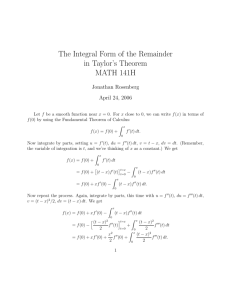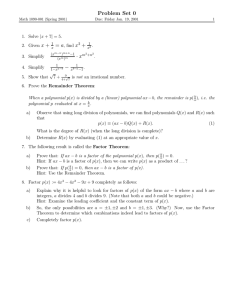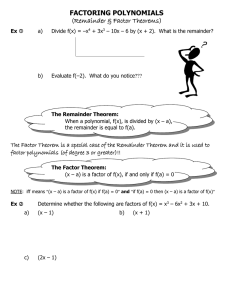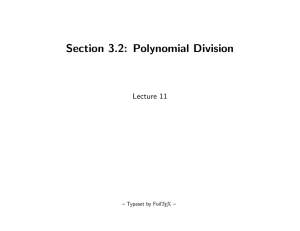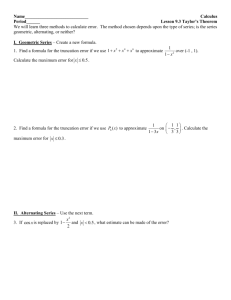Lesson 10 – Remainder Theorem and Factor Theorem
advertisement
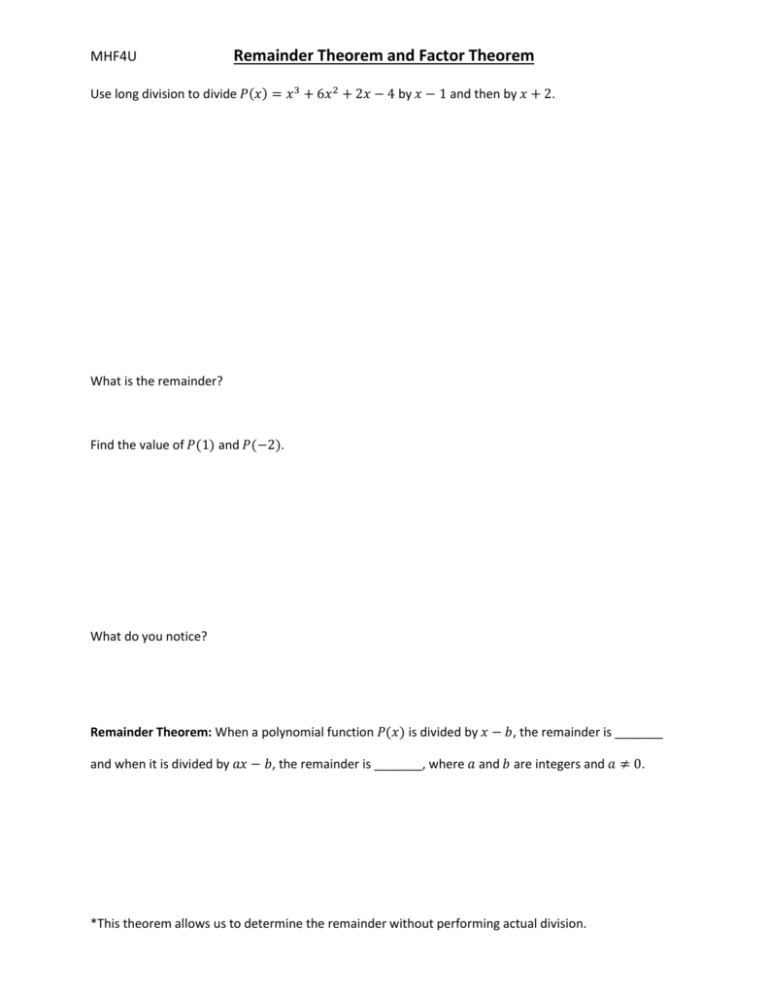
MHF4U Remainder Theorem and Factor Theorem Use long division to divide 𝑃(𝑥) = 𝑥 3 + 6𝑥 2 + 2𝑥 − 4 by 𝑥 − 1 and then by 𝑥 + 2. What is the remainder? Find the value of 𝑃(1) and 𝑃(−2). What do you notice? Remainder Theorem: When a polynomial function 𝑃(𝑥) is divided by 𝑥 − 𝑏, the remainder is _______ and when it is divided by 𝑎𝑥 − 𝑏, the remainder is _______, where 𝑎 and 𝑏 are integers and 𝑎 ≠ 0. *This theorem allows us to determine the remainder without performing actual division. Example 1 Find the reminder when 3𝑥 2 − 2𝑥 2 + 𝑥 − 5 is divided by 𝑥 + 2. Example 2 Find the remainder exactly when 𝑥 3 − 4𝑥 2 + 2𝑥 − 6 is divided by 2𝑥 − 1. Example 3 When 𝑥 3 − 𝑘𝑥 2 + 17𝑥 + 6 is divided by 𝑥 − 3, the remainder is 12. Find 𝑘. How do we factor polynomials of degree 3 or higher? Example: 𝑓(𝑥) = 𝑥 3 + 8𝑥 2 + 19𝑥 + 12 Factor theorem: (𝑥 − 𝑏) is a factor of a polynomial 𝑃(𝑥) iff (if and only if) ______________. Similarly, (𝑎𝑥 − 𝑏) is a factor of 𝑃(𝑥) iff __________ Example 4 Is (𝑥 − 2) a factor of 𝑥 3 − 7𝑥 2 + 9𝑥 + 2? Example 5 a) Find a factor of 𝑥 3 + 8𝑥 2 + 19𝑥 + 12 b) Use the factor from a) to fully factor the polynomial 𝑥 3 + 8𝑥 2 + 19𝑥 + 12 What happens when we have a leading coefficient that is not 1? 𝑏 𝑎 Rational zero theorem: If 𝑃(𝑥) is a polynomial function with integer coefficients and 𝑥 = is a zero of 𝑃(𝑥), where 𝑎, 𝑏 are integers and 𝑎 ≠ 0 then 𝑏 is a factor of the constant term 𝑎 is a factor of the leading coefficient 𝑎𝑥 − 𝑏 is a factor of 𝑃(𝑥) Example 6 a) List possible factors of 5𝑥 3 + 3𝑥 2 − 12𝑥 + 4 b) Find the factor of 5𝑥 3 + 3𝑥 2 − 12𝑥 + 4 c) Factor 5𝑥 3 + 3𝑥 2 − 12𝑥 + 4 Example 7 Factor a) 𝑥 3 − 𝑥 2 − 14𝑥 + 24 b) 𝑥 3 − 4𝑥 2 + 𝑥 + 6
